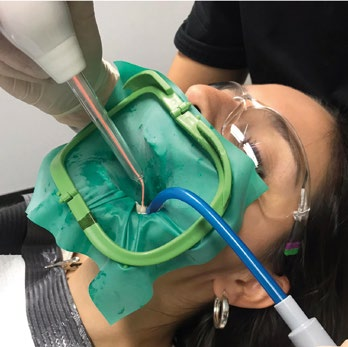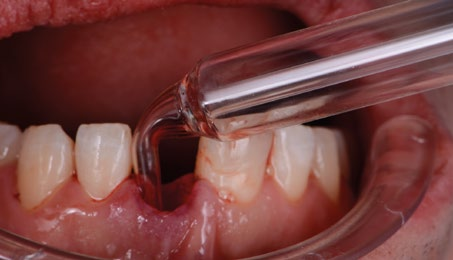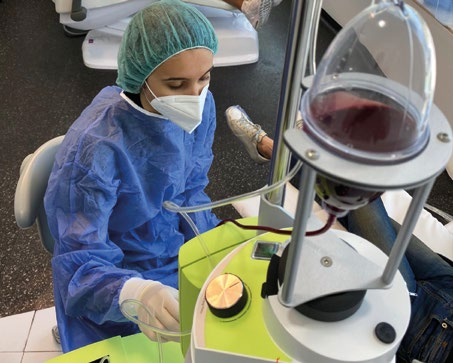The oral cavity is an open ecosystem, with a dynamic balance between the entry of microorganisms, their colonisation, and the host’s defense, which aims to remove pathogens. To prevent their elimination, bacteria need to adhere to hard dental surfaces or epithelial surfaces. The formation and development of the oral biofilm and the internal selection of specific microorganisms were correlated with the most common oral pathologies, such as dental caries, periodontal disease and peri-implantitis. Mechanical removal of biofilm and the adjunctive use of disinfectants and antibiotics have been the conventional methods for periodontal therapy.
What is ozone?
Ozone (O3) is a triatomic molecule, composed of three oxygen atoms, and its application in medicine and dentistry is indicated for the treatment of more than 260 different pathologies. Ozone therapy has been shown to be quite beneficial compared to conventional therapeutic modalities that follow a minimally invasive and conservative application in dental treatment. The exposure of the molecular mechanisms of ozone has benefits not only in the treatment of periodontal diseases, but also in the surgical scope after a tooth extraction and in the implant bed preparation.
At White Clinic, we have been applying ozone therapy since 2017 with very good results. I can say that there is no oral surgery (extraction, cavitation or implant placement) or periodontal procedure in which we do not apply ozone therapy. We even use it for the disinfection of dentin after the removal of deep caries. Ozone therapy has become an essential process in our clinical practice.
What diseases does ozone treat in dentistry?
Periodontitis is a destructive inflammatory disease of the supporting tissues of the teeth and is caused by specific microorganisms, resulting in the progressive destruction of the periodontal ligament and alveolar bone with periodontal pocket formation, gingival recession or both1. Bacteria are the main etiologic agents of periodontal disease, and it is estimated that more than 500 different bacterial species are able to colonise the adult oral cavity2 and oral cavity lesions have a profound impact on the quality of life of patients with complex advanced diseases3. Periodontitis has been associated with having an etiologic or modulatory role in cardiovascular and cerebrovascular disease, diabetes, respiratory disease, and adverse pregnancy outcomes, and several mechanisms have been proposed to explain or support these theories.
The formation and development of the oral biofilm and the internal selection of specific microorganisms were correlated with the most common oral pathologies, such as dental caries, periodontal disease and peri-implantitis5. The nature of a microbial community offers advantages to participating microorganisms. These advantages include a wider range of habitat for growth, improved resistance to antimicrobial agents and host defense, and a greater ability to cause disease6. The pathogenicity of dental biofilm in the oral cavity is amplified by two biofilm characteristics: increased antibiotic resistance and the inability of the community to be phagocytosed by the host’s inflammatory cells7. Mechanical removal of biofilm and the adjuvant use of disinfectants and/or antibiotics have been the conventional methods for periodontal therapy8,9. Nowadays, research groups are looking for alternatives to antibiotic treatments (due to biofilm resistance), and more and more therapies such as ozone application seem to have a promising future.
In 1839, Christian Friedrich Schonbein first identified the emergence of a pungent gas with an electric smell. According to the Greek language, Schonbein named this gas “ozone” and presented a lecture at the Basel Natural Science Society with the following title: “The odor at the positive electrode during the electrolysis of water”10. Oxygen/ozone therapy has a long history of research and clinical application in humans. The first medical application occurred in 1870, when Dr. C. Lender purified blood in test tubes. The medical applications were promoted across Europe and America.
In 1929, more than 114 diseases were indicated for treatment with oxygen/ozone therapy. Interestingly enough, in 1930, a German dentist, Dr. E.A. Fisch, began applying ozone regularly in his clinical practice in Zurich, Switzerland, and published several articles on the topic.
More recently, a group from Germany with whom we are doing research, has identified some inflammatory foci in the maxillary and mandibular bones. These jaw cavitations are characterised by necrotic bone marrow fractions and the fatty degenerative osteonecrosis of the maxillary bone (FDOJ) can be painful or remain asymptomatic for years. Due to the softening of the bone substance, the medullary space can be curetted. The cancellous bone degeneration extends to the mandibular areas, reaching the inferior alveolar nerve canal. Areas affected by FDOJ can be impacted by the over-expression of inflammatory mediators, such as CCL5 chemokine, also known as RANTES (Regulated upon Activation, Normal T-cell Expressed and Presumably Secreted). The origin of these cavitations may be due to cystic lesions associated with endodontic teeth, cysts/dental infections that were not completely removed after a tooth extraction, or may be associated with non-integrated dental implants. The use of ozone therapy in the post-extraction procedure for cleaning the site is crucial in preventing the appearance and elimination of RANTES. Ozone is also applied to the mandibular and maxillary bones during the FDOJ elimination procedure.
The application of ozone therapy in dentistry is mostly topical. However, the dentist should consider applying the major autohemotherapy method with ozone to also treat the patient at a systemic level, as sometimes this inflammation and/or infection may already be affecting the patient’s general health.

Ozone therapy: chemistry and function
Ozone (O3) is a triatomic molecule composed of three oxygen atoms, a thermodynamically highly unstable molecule that, depending on system conditions such as temperature and pressure, decomposes into pure oxygen11. Ozone is 1.6 times denser and 10 times more soluble in water (49.0 ml in 100 ml of water at 0°C) than oxygen. Ozone is the third most potent oxidant (E_ 5 12.076 V) after fluorine and sulphate.
Ozone is an unstable gas that cannot be stored and must be used immediately because it has a half-life of 40 min at 20°C12. It is produced naturally by the photodissociation of molecular oxygen (O2) into activated oxygen atoms, which react with other oxygen molecules. This transient radical anion quickly becomes a proton, generating hydrogen trioxide (HO3) which, in turn, breaks down into an even more powerful oxidant, the hydroxyl radical (OH).
It is the fundamental form of oxygen that occurs naturally as a result of ultraviolet energy or lightning, causing a temporary recombination of oxygen atoms in groups of three. In the clinical setting, an oxygen/ozone generator simulates lightning by means of an electrical discharge field. Ozone gas has a high oxidation potential and is 1.5 times greater than chloride when used as an antimicrobial agent against bacteria, viruses, fungi and protozoa. It also has the ability to stimulate blood circulation and immune response. Such characteristics justify the current interest in its application in medicine and dentistry. Nowadays, this therapy has been indicated for the treatment of 260 different pathologies13.
The potential application of ozone therapy in the human body and its biological horizons are listed in table 1. The antimicrobial effect of ozone is the most studied. Oxygen/ozone therapy in dentistry contains multiple protocols for dealing with dental infections. Three fundamental forms of application are applied to oral tissue: (1) ozonated water, (2) ozonated olive oil, and (3) oxygen/ozone gas. Ozonated water and olive oil have the ability to trap and release oxygen/ozone, an ideal delivery system. These application forms are used alone or in combination to treat dental diseases. The different clinical applications of ozone therapy in the fight against dental diseases and its treatment modalities are described in table 2. Ozone therapy also has certain limitations and contraindications, as presented in table 3.
Compared to traditional medicine modalities such as antibiotics and disinfectants, ozone therapy is much more cost-effective; will significantly reduce medical costs and increase treatment effectiveness.
Dental medicine is evolving with the introduction of functional therapies in dental practice. Ozone therapy has been shown to be more beneficial than conventional therapeutic modalities that follow a minimally invasive and conservative application in dental treatment. The exposure of the molecular mechanisms of ozone further benefits the practice of dentistry in the treatment of oral diseases. Treating patients with ozone therapy shortens treatment time and eliminates the bacterial load more specifically. The treatment is painless and patient satisfaction is high, with almost zero adverse effects. The contraindications of this method should still be taken into account. More research is needed to regulate the indications and treatment procedures of ozone therapy.

Table 1: Applications of ozone therapy
- Antimicrobial damage (bactericides, viricides and fungicides) to the cytoplasmic membrane;
- Oxidation of intracellular content;
- Effective in case of antibiotic resistance;
- Immunostimulant;
- Activates the cellular and humoral immune system. Immunocomplement cell proliferation. Synthesis of immunoglobulins;
- Increase phagocytosis activity;
- Activation of biological antioxidants;
- Analgesic;
- Anti-hypoxic and detoxifying;
- Activation of the aerobic process (Krebs cycle, glycolysis, fatty acid oxidation);
- Bioenergetic and biosynthetic;
- Activates protein synthesis;
- Improved cellular metabolism (mitochondria);
- Synthesis of interleukins, leukotrienes and prostaglandins; Immunoglobulin synthesis.

Table 2: Applications of ozone therapy in dentistry
- Elimination of bacterial pathogens;
- Disinfection of periodontal pocket and bone disinfection;
- Prevention of dental caries;
- Endodontic treatment;
- Dental extraction;
- Tooth sensitivity;
- Treatment of the temporomandibular joint;
- Gingival recession (exposed root surfaces);
- Pain control;
- Infection control;
- Accelerated healing;
- Tissue regeneration;
- Control of halitosis (bad breath);
- Remineralisation of the tooth surface;
- Teeth whitening;
- FDOJ treatment.
Table 3: Contraindications for ozone therapy
- Pregnancy;
- Autoimmune hyperthyroidism diseases;
- Anaemia;
- Myasthenia;
- Alcohol intoxication;
- Stroke, haemorrhage, myocardial infarction;
- Ozone allergy/Allergy to ozone.
*Dr. Ana Paz, Science, Research and Daily Practice at White Clinic
REFERENCES
- Saini R, Saini S, Sharma S. Periodontal disease linked to cardiovascular disease. J Cardiovasc Dis Res 2010;1:161-2
- Saini R, Marawar PP, Shete S, Saini S. Periodontitis a true infection. J Global Infect Dis 2009;1:149-51.
- Saini R, Marawar PP, Shete S, Saini S, Mani A. Dental expression and role in palliative treatment. Indian J Palliat Care 2009;15:26-9.
- Saini R, Saini S, Sharma S. Periodontitis: A risk factor to respiratory diseases. Lung India 2010;27:189.
- Bortolaia C, Sbordone L. Biofilms of the oral cavity. Formation, development and involvement in the onset of diseases related to bacterial plaque increase. Minerva Stomatol 2002;51:187-92.
- Marsh PD. Dental plaque: Biological significance of a biofilm and community life-style. J Clin Periodontol 2005;32:7-15.
- Thomas JG, Nakaishi LA. Managing the complexity of a dynamic biofilm. J Am Dent Assoc 2006;137:10-5
- Walker CB. The acquisition of antibiotic resistance in the periodontal micro flora. Periodontol 2000 1996;10:79-88.
- Feres M, Haffajee AD, Allard K, Som S, Goodson JM, Socransky SS. Antibiotic resistance of sub gingival species during and after antibiotic therapy. J Clin Periodontol 2002;29:724-35.
- Stübinger S, Sader R, Filippi A. The use of ozone in dentistry and maxillofacial surgery: A review. Quintessence Int 2006;37:353-9.
- Burns DT. Early problems in the analysis and the determination of ozone. Fresenius J Anal Chem 1997;357:178-83.
- Bocci VA. Scientific and Medical Aspects of Ozone Therapy: State of the Art. Arch Med Res 2006;37;425-35.
- Nogales CG, Ferrari PH, Kantorovich EO, Lage-Marques JL. Ozone therapy in medicine and dentistry. J Contemp Dent Pract 2008;9: 75-84.






